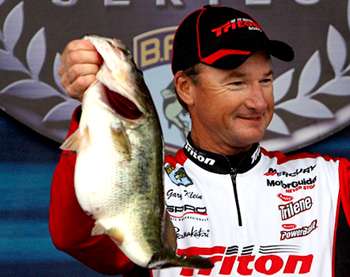
Locating bass on an expansive flat can be, at the best of times, challenging. Often located in wide open water and stretching for hundreds of yards, the prospect of combing a flat in search of bass can seem like a fruitless and time-consuming endeavor. Elite Series pro and tournament veteran Gary Klein admits that an angler blindly casting across an expansive flat will have a difficult time pinpointing schools of feeding bass.
"If you're looking at a flat, you need to be there for a reason," explains Klein. "Either the depth is right or the bass are pushing bait up on the flat. It takes a good amount of time to 'work out' a flat."" While the exact depth of a flat varies according the fishery, they are generally shallow. As a result, Klein believes the most productive way to identify key areas on a flat is to fish with his trolling motor down while paying attention to the electronics on the bow of his Triton.
"I'm always looking for key features on the flat that will hold groups of fish," he says. "It can be aquatic vegetation like milfoil and hydrilla or it could be stumps. Current is another great reason why I fish flats." Klein believes that when current is present, the time spent searching for productive areas on a flat can be greatly reduced. "Current will position the bass in a way that the flat doesn't really seem so big. Because the bass will be facing upcurrent, I'm going to fish the upcurrent side of the flat and the very end of the flat."
Keying on the edge of a flat where it drops off into deeper water is often a productive method when bass are feeding. Klein explains that schools of bass will actually hold in the deeper water and then push the bait up on the flat and begin gorging. "The bass will use the shallow water on a flat almost like a table top to push bait up on top and create a feeding zone," he explains. Crankbaits, spinnerbaits and topwaters are Klein's go-to offerings when targeting bass on the flats, but his presentation varies depending on the species of bass he is targeting.
"If I'm fishing for smallmouth bass, flats are golden because they love to use them to spawn," says Klein. "I'm going to look for any type of rock, because smallmouth love rock. I'll also use a technique that I call 'speed reeling.'" Klein explains that smallmouth are hardwired to chase fast-moving baits, and burning a high-speed reel as fast as possible across a flat can trigger some vicious strikes from aggressive smallmouth. "What I'm doing is challenging the smallmouth to attack the bait because it's moving so fast."
When targeting smallmouth on flats, Klein leans toward a chartreuse lipless crankbait or a spinnerbait. When targeting spotted bass on flats, Klein is more likely to opt for topwater offerings, jerkbaits and shallow running crankbaits. When it comes to largemouth, he will use the same offerings but key more closely on vegetation and current. By paying attention to your electronics, spending a lot of time on the trolling motor, covering water and picking up on subtle differences like bottom composition and current, finding and catching bass on flats can become a productive option that many other anglers overlook.




